Everything You Wanted to Know About SmartHub in 1 Guide
 by Roman Vrublivskyi
by Roman Vrublivskyi
 by Roman Vrublivskyi
by Roman Vrublivskyi
SmartHub is a white label PaaS advertising exchange that provides rapid entry into the ad tech marketplace thanks to the customer-centric approach and pre-built technology.
What is White Label ad exchange? Who is SmartHub for, and what results does it bring to its clients? Which SmartHub`s features and capabilities help programmatic businesses in getting great ROI and revenues? The answers to these and many other questions you will find in this article.
SmartHub is about creating independent advertising solutions for businesses. It includes comprehensive, proactive customer care and the support of dedicated experts who are doing everything they can to help you achieve outstanding business results.
Deploying a new ad tech platform is no easy task, so comprehensive customization, training, and customer support are our number one priority. We’ll work side by side with you, constantly guiding you, advising you, and making sure your business grows.
SmartHub is designed to help businesses build a scalable and efficient programmatic ad marketplace.
SmartHub is needed to allow businesses to focus on their core tasks while the platform and our experts ensure that their advertising campaigns and platforms are running reliably. The SmartHub technology is designed for development and growth.
For example, the SmartHub White Label platform is perfect for a business that decided to build a platform on its own, an independent solution that it can manage and make money from. This is something that will allow the business to get additional income and grow faster.
White Label ad exchange is a programmatic advertising exchange platform manufactured by an ad tech vendor, purchased and labeled by another enterprise. It is prebuilt. WL platforms can be easily compared to already existing programmatic platforms; the difference is that such a platform, in fact, is the property of the brand.
So, is the White Label platform a new programmatic platform developed from scratch?
Yes and no. White Label is a standard off-the-shelf platform with a common set of functions. Such a platform can be easily customized and scaled to the owner’s needs. However, it is not developed from scratch but based on a prebuilt core.
Usually, the platform owner can change the logo, host the platform on their domain, set up the display of API links and RTB endpoints from their domain, etc.
The main advantage of this platform is that it requires fewer resources to create and maintain its work. It is much cheaper than creating a programmatic platform from scratch; moreover, when you buy a White Label platform, you do not need to hire additional people to develop the platform.
SmartHub helps businesses grow and develop. First, having your own advertising platform gives you unlimited opportunities to improve your digital marketing, including making sure your advertising system is as secure as possible. Secondly, SmartHub is constantly evolving and adding innovations to its product that allow businesses to generate more revenue without actually doing anything for it.
For example, in the spring of 2022, we released a new version of our platform, SmartHub 2.0. Our clients switched to this version in May 2022, and by the end of July, you could see the impact the switch to the new platform had on their business.
The data in this chart is anonymous to protect our customers’ privacy.
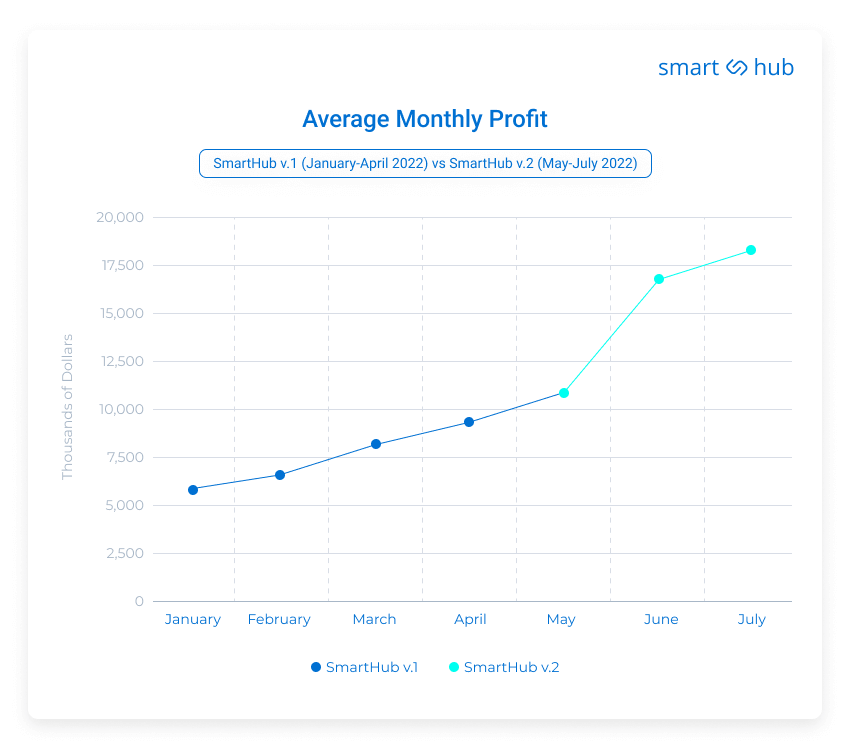
The transition to the new version of the platform greatly accelerated the profit growth of our clients: during the period (from April to July, when many partners switched from SmartHub v1 to SmartHub v2), the average monthly profit growth was 102.65%, and the average daily profit was 98.45%. At the same time, they remained on the old QPS rates, i.e., they did not pay extra for profit growth.
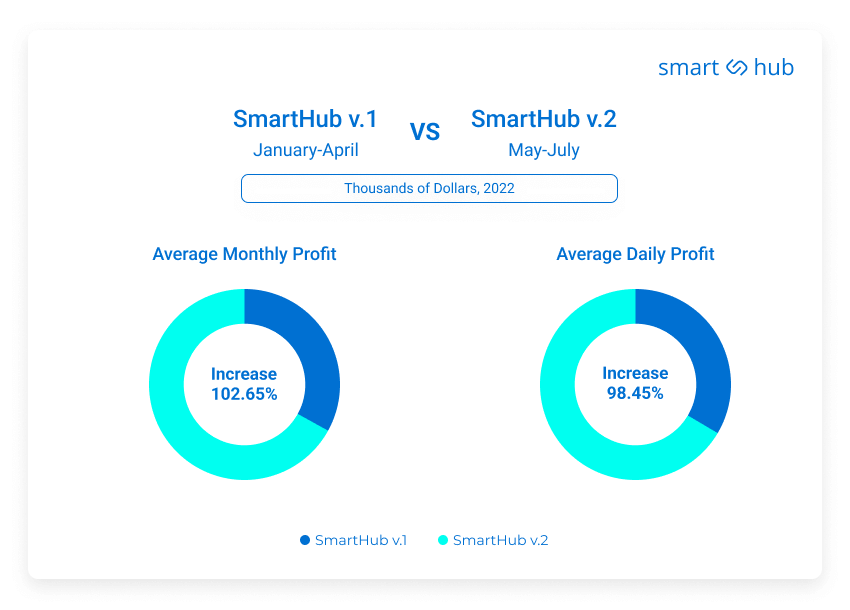
You can read more about how SmartHub 2.0 increased the profits of our clients.
The Supply Side Platform (SSP) is the primary inventory aggregator in programmatic advertising. Publishers use the SSP to automate the media sales process and effectively manage their advertising space in real time.
Demand Side Platform (DSP) is a platform through which traffic is purchased. Advertisers use DSPs to automate the ad buying process and manage ad campaigns in real time from a single location.
You can integrate your partner SSP or DSP within your marketplace. This way, you’ll create your own environment where demand and supply trade, making you, as the platform owner, profit from these bidding and create an exclusive ad network that meets your security needs.
Sometimes brand partners require specific types of integration not provided by SmartHub’s standard solution. But even in this case, our experts are ready to do their best to make any integration possible and beneficial for all parties.
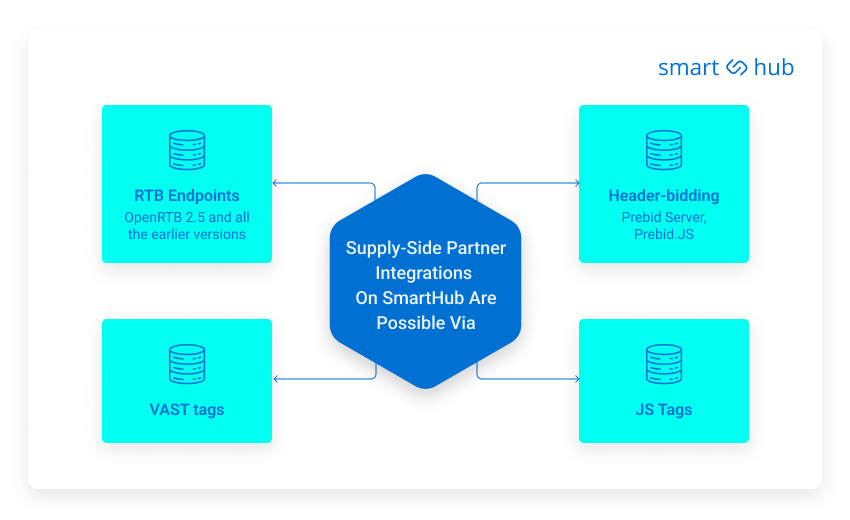
No need to be scared of new words; here we explain it all!
The fact is that programmatic advertising usually uses a waterfall auction. The essence of this model is that vendor partners take turns offering advertising impressions, gradually lowering the price threshold until the impression sells out. This model works quite well, but it does not provide equal opportunity for bidders.
Prebid auctions, on the other hand, allow demand partners to bid on ad inventory simultaneously, which provides fair access to inventory and creates better competition as well as higher returns for delivery partners.
In fact, this technology not only makes programmatic advertising fairer and more affordable, but it also makes it more technologically advanced since it can accelerate the speed at which pages load and ads are displayed (thanks to the server-side auctions).
You can learn more about Prebid server integrations.
VAST is a template for displaying video ads. It is a specification (XML schema) developed by the Interactive Advertising Bureau (IAB) that contains all the information about the media ads: physical location, format (also VAST URL to be called at certain events), etc.
VAST is usually used as a tag for video ad customization and is commonly talked about in the context of video ads, too. However, on our platform, you can use it for serving audio ads as well. Actually, it can also be used for inline ads, linear videos, overlays. And the last standard for this template is capable of transferring large amounts of media files, which greatly expands its potential advertising utility.
VAST tags work great for serving ads in interactive media, as well as greatly expanding your analytics capabilities.
In the latest update, we’ve simplified it for our customers and made sure that those different connections “understand” each other. No need to whitelist every endpoint on the platform to create a VAST to RTB or VAST to VAST connections – media buying and selling are practically universal.
You can trade not only VAST to VAST or RTB to RTB but also in a VAST to RTB, RTB to VAST, and VAST to all ways.
Here’s how you can do it in the dashboard while adding demand endpoints:
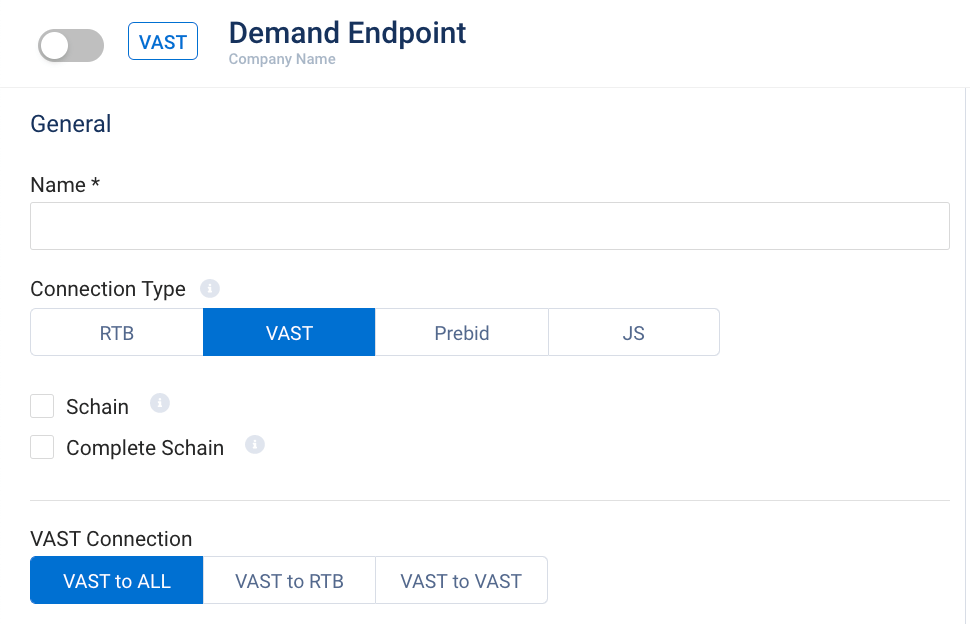
Here’s how you can do it in the dashboard while adding supply endpoints:
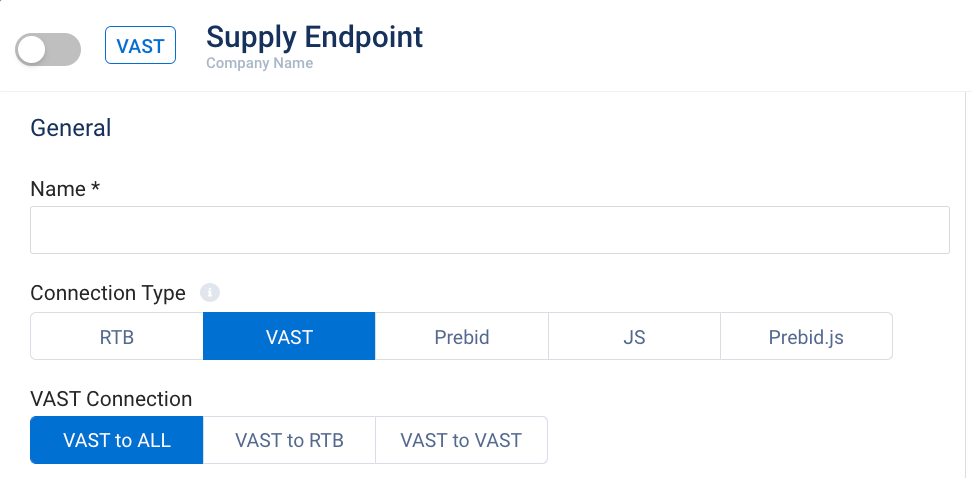
Learn more what is VAST tag and how to create him.
For effective digital marketing, you need to use different advertising formats configured for various devices. Our platform can provide you with the most relevant and effective tools for the boldest and most creative advertising campaigns in the online space.
In addition to the classic banner ads that even the most ordinary Internet users probably know about, SmartHub has more sophisticated formats that have gained popularity relatively recently.
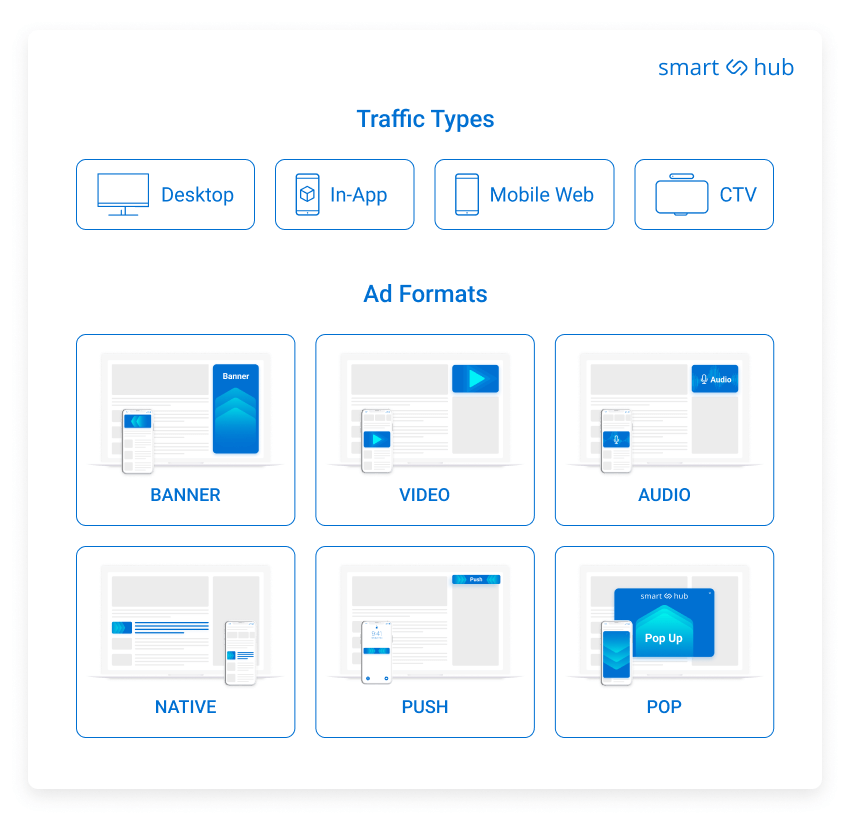
Streaming services have become the salvation for many people bored at home during the Covid quarantine. For the advertising world, though, they’ve become a great opportunity to grow CTV’s advertising business.
With 92% of households available for programmatic advertising through CTV devices in 2022, this is a great opportunity for brands to reach their target audience. It’s worth keeping in mind that almost all streaming services have the option of a more expensive ad-free rate, but there’s no need to worry that this will render advertising on CTV useless. Surveys show that U.S. residents prefer a cheaper plan with ads rather than a more expensive plan with no ads.
There are about 6.648 billion people in the world right now who own smartphones. And every one of those smartphones has apps in which you can show ads. There are several types of ads in apps (and each of them can be set up on SmartHub): banner ads, cross-page ads, interactive ads, native ads, and video ads.
An advertising banner is displayed in the background on the part of the screen, which is not necessary for the functionality of the app. Ad banners change from time to time.
Native ads are tweaked to the interface of the app and do not stand out from the main content in it. However, such ads are always marked with a note that it is an advertising publication.
Pop is an advertising banner that pops up on top of the page a user is viewing. The user cannot interact with the main content while the banner is open.
Push notifications are short pop-up notifications of limited length (usually a header and 125 characters) that appear on a user’s computer or phone screen.
Video ads in the app can be presented as cross-page ads, or they can be rewarded videos. Rewarded videos are mostly used for in-game ads: after watching the video, the user is offered in-game resources.
SmartHub is always moving with time and sometimes even ahead of it. We try to give our clients every opportunity to implement the most effective and relevant advertising campaigns in the digital space. That’s why our platform has so many possibilities in operation. All our tools are flexible and adaptive and can adjust to the specifics of any business.
Programmatic advertising fraud is one of the most critical industry challenges at the moment. Research shows that out of every 3 dollars spent on advertising, 1 dollar ends up in the pockets of fraudsters.
Of course, we are aware of this problem, and we can’t ignore it because it can directly and strongly influence the quality of our services. That’s why we use actual methods of protecting our clients developed by IAB.
Currently, the most effective anti-fraud standards are ads.txt and sellers.json files. Ads.txt is a text file that allows publishers to specify sellers who are allowed to sell their advertising resources to them. This file is publicly available, and buyers can review it to make sure they are dealing with a legitimate vendor from their publisher.
Sellers.json is similar in concept to ads.txt, but it is hosted by an SSP. Sellers.json allows advertisers to identify all parties involved in selling the publisher’s advertising resources, if necessary.
The standards for these files are updated regularly, continually improving the level of fraud protection they provide for brands.
And here, you can learn about all the types of scanners used on SmartHub to protect brand data and optimize the entire system (there are a lot of them, and they’re all very cool).
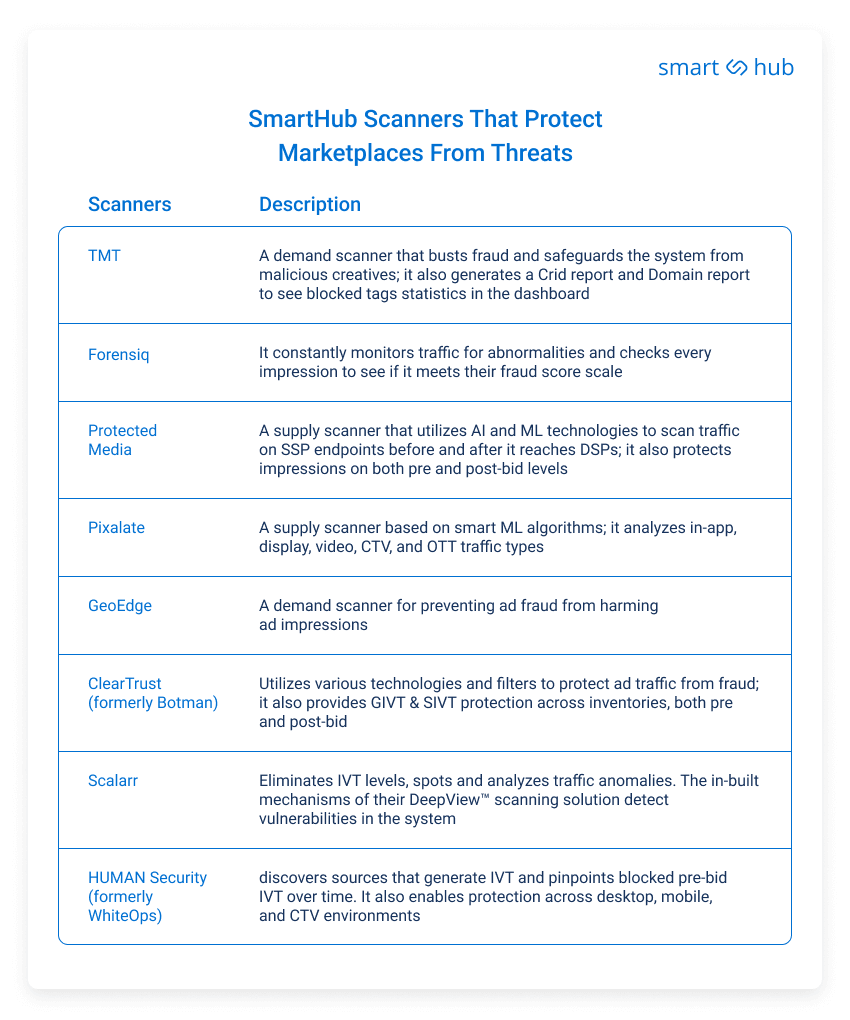
Privacy Compliance is a company’s compliance with established rules, specifications, or legislation to protect personal data.
All the tools we use at SmartHub are created in compliance with all international privacy standards. We only collect anonymized data for display advertising, so you can have confidence in privacy-friendly and compliant advertising.
The information we collect is pseudonymous, aggregated, and not considered personal information in most jurisdictions.
In order to get the traffic you want, there is a traffic filtering feature that allows us to analyze traffic, learn what types of traffic DSPs prefer, and then send more of that traffic to those DSPs.
We use a QPS adapter to filter the traffic. It learns what types of traffic are most preferred by each DSP. Once the QPS adapter analyzes which type of traffic generates the most responses to bids, it starts sending more of that traffic to those DSPs that need it.
The adapter uses several parameters: country, device size/type, secure/insecure connection type, etc., to determine which traffic is needed.
This feature allows us to deliver only quality traffic that brings the results you need.
Besides that, we also use more usual tools for traffic filtration. These include Mismatched IPs and Bundles throttling, IFA and IPv4 missing requests throttling, Secured traffic filtering, Adult traffic filtering, Blocked CRIDs, and Blocked categories.
In order for ads to work for the desired result, it’s critical that it is delivered to their target audience. That’s why SmartHub has an excellent targeting system that allows demand partners to target the category of users they want with great precision, even if they are very specific. The criteria include Traffic type, Ad Format, Ad Sizes, Geo, Sources and Publisher Ids, Connection type, Device OS targeting, and more.
Targeting is the backbone of programmatic advertising. It’s what makes it so valuable in the modern world. That’s why we strive to make our targeting the ultimate example of quality in the world of digital advertising.
Optimization tools allow you to build your advertising strategy more effectively and take greater advantage of SmartHub. Our tools are based on Machine Learning and Artificial Intelligence, so they are constantly evolving.
Using each of the optimization tools is very easy — you just need to set up the parameters you want your system to work according to, and then it will automatically align your media trading and optimize it.
For example, with a QPS adapter, you can effectively match traffic from vendor partners to the demand partners that need it most.
And using a traffic logger can help you take a detailed look at how much and what kind of traffic your marketplace is getting. In order to do so, you just need to set filtering parameters and run the process.
The request and response logger can check bid requests from SSPs and responses to bid requests from DSPs. And the request and response samples logger will allow you to find sample requests/responses sent from and to specific SSP and DSP partners. This data is extremely useful in optimizing and planning your work with the platform.
SmartHub contains a huge number of analytical tools with the help of which you can analyze every process taking place in the system. Such tools are necessary because they allow you to make the work of both the platform and the specialists more efficient.
We try to update our analytical tools as often as possible. For example, with the launch of SmartHub 2.0, we added extra analytical tools: more than 20 new metrics and measurements to help you analyze the performance of your system in even greater depth. Among them: Fill Rate%, Render Rate%, Bid Rate%, SSP and DSP RCPM, Avg. SSP and DSP Bidfloor, Average SSP and DSP Bid Price, etc.
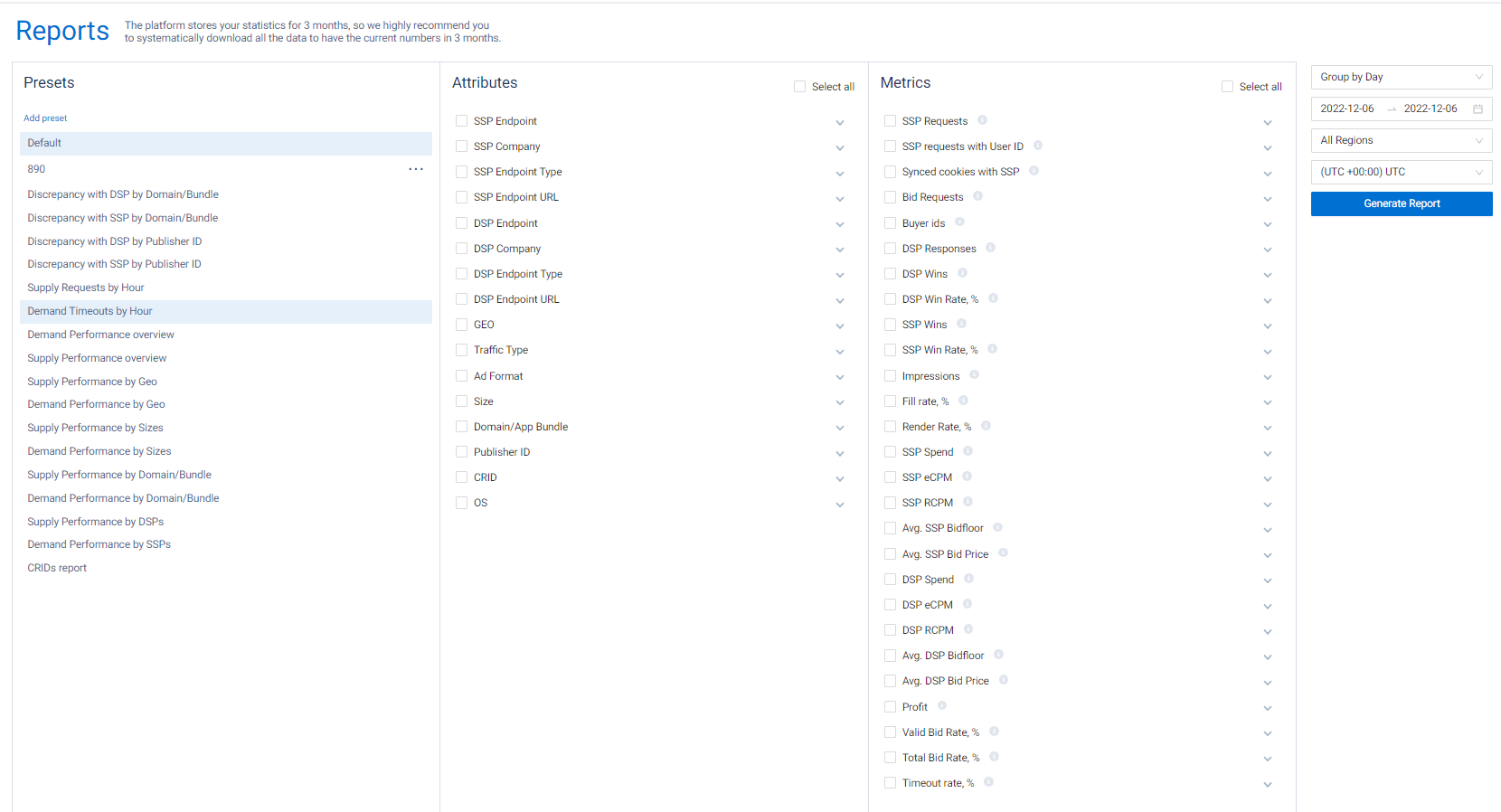
In addition, we are constantly optimizing the performance and usability of all of our metrics.
We tried to cover the most important features and benefits of SmartHub, but you might not find the information you were looking for. If so, you can take a look at our FAQ page or just contact us.
Start your journey to programmatic advertising with SmartHub now!
Want to Learn More?
Want to Learn More?
We'll get back to you very soon.